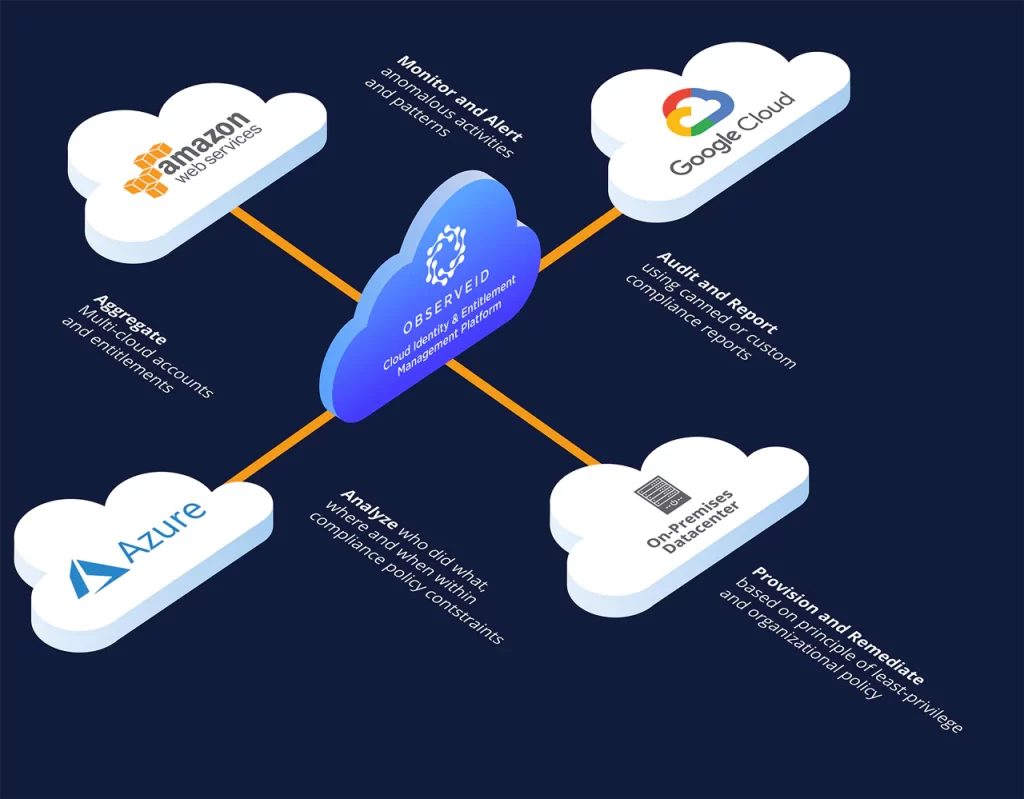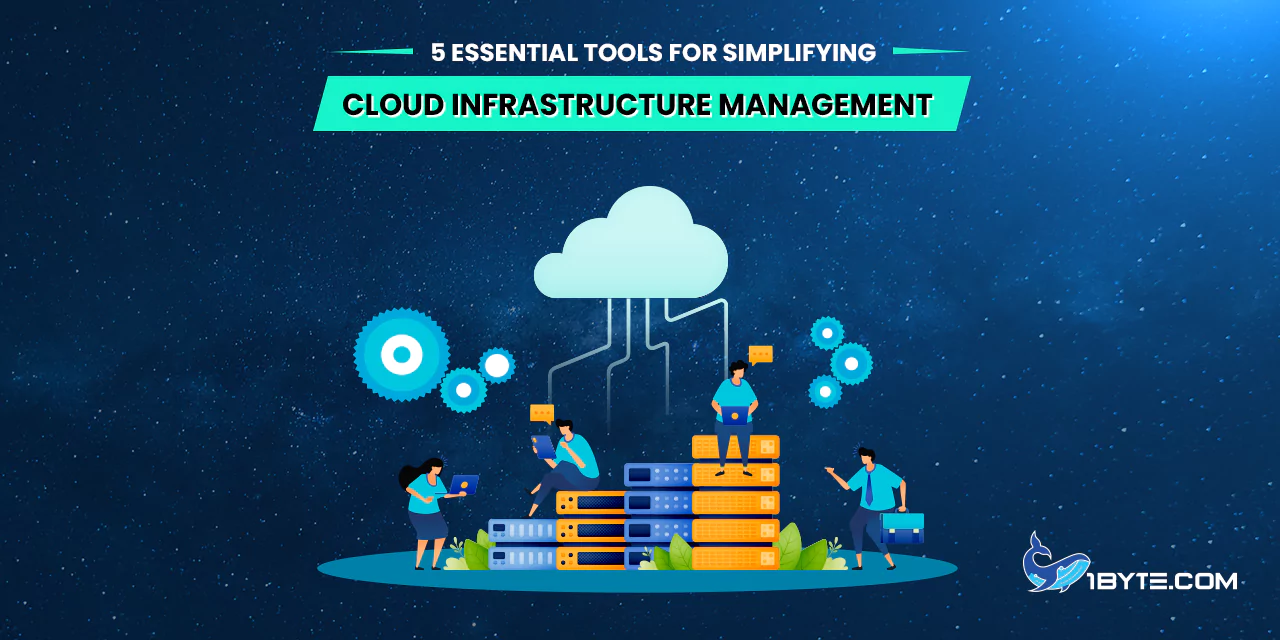Imagine being exhausted from grappling with the complexity of managing your cloud infrastructure. Visualize this: you’re overseeing a thriving business, but the once easily manageable cloud environment has transformed into a complicated labyrinth of services, providers, and configurations. It feels like attempting to navigate through an intricate maze while blindfolded—frustrating, time-consuming, and constantly causing concerns about the stability and security of your infrastructure.
But rest assured! This blog from your favorite cloud firm 1Byte will provide you with the indispensable tools to simplify your cloud infrastructure management challenges. We understand the overwhelming nature of this task, and that’s why we have carefully curated this guide to address the pain points you may be experiencing.
From automated monitoring and orchestration to streamlined deployment and cost optimization, we’ll cover it all. With these tools covering 5 most important aspects of cloud infrastructure management in your arsenal, you’ll not only regain control but also unlock the full potential of your cloud infrastructure. Say goodbye to endless complexity and hello to efficiency, scalability, and peace of mind.
Server Administration Tools
Server administration plays a vital role in effectively managing cloud infrastructure. To ensure seamless operations, businesses require reliable and efficient tools. Explore the following five essential server administration tools that can simplify the management of your cloud infrastructure:
1. Server Monitoring and Performance Management
Server monitoring tools enable businesses to continuously track the performance of their cloud infrastructure in real-time. These tools offer valuable insights into server metrics like CPU usage, memory utilization, network traffic, and disk I/O. By closely monitoring these metrics, businesses can optimize their cloud infrastructure for utmost efficiency and optimal performance.
Some popular server monitoring tools include:
- Nagios is an extensively utilized open-source tool known for its comprehensive monitoring capabilities and alert notifications.
- Datadog is a cloud-based monitoring platform that provides users with a comprehensive perspective on system performance. It seamlessly integrates with popular cloud providers, offering an enhanced operational experience. Additionally, Datadog features advanced analytics capabilities to
- New Relic is renowned for its Application Performance Monitoring (APM) capabilities. It offers comprehensive server monitoring, empowering users with robust diagnostics and troubleshooting features.
2. Configuration Management Tools
Configuration management tools help businesses automate the process of provisioning and managing servers. These tools empower administrators to establish and uphold configuration standards, promoting consistent and dependable server setups throughout the infrastructure.
Popular configuration management tools include:
- Puppet is an extensively utilized open-source tool that streamlines configuration management, software deployment, and orchestration processes.
- Ansible is an open-source tool renowned for its simplicity and user-friendly interface. It empowers businesses to automate server provisioning, configuration, and application deployment effortlessly.
- Chef is a powerful tool designed for effortlessly managing infrastructure as code. It offers a wide range of features, including server configuration, seamless application deployment, and robust policy enforcement.
3. Backup and Disaster Recovery Tools
Data loss can pose significant risks for businesses, leading to dire consequences. In order to mitigate these risks effectively, it becomes paramount to establish robust backup and disaster recovery mechanisms. By utilizing backup and disaster recovery tools, businesses can create and manage backups of their cloud infrastructure. This ensures data availability and facilitates prompt recovery in the face of unforeseen events.
Popular backup and disaster recovery tools include:
- Veeam is a robust data protection platform specifically designed for virtual environments. It provides a comprehensive range of features including backup, replication, and recovery capabilities.
- Commvault is a widely-used enterprise backup and recovery solution that supports multiple cloud platforms and provides efficient data deduplication and management capabilities.
- Acronis Cyber Backup is a dependable tool for backing up and recovering data, offering various deployment options and excellent support for multiple cloud platforms.
Recommended reading: Shared Hosting Prices: A Guide to Finding Affordable Options
Security and Package Management Tools
In today’s digital landscape, ensuring the security and proper management of cloud infrastructure holds paramount importance. This is where security and package management tools step in as crucial players. These tools serve to protect your cloud environment against threats and vulnerabilities while also streamlining package management. Let’s delve into some essential security and package management tools that can simplify the process of managing your cloud infrastructure.

1. Vulnerability Scanners
Vulnerability scanners serve as powerful tools that assist in the identification of potential weaknesses and security loopholes within your cloud infrastructure. These comprehensive scanning instruments diligently detect outdated software, misconfigurations, and known vulnerabilities. By incorporating regular scans into your infrastructural maintenance routine, you can proactively address security concerns before they escalate into major issues.
2. Intrusion Detection Systems (IDS)
An Intrusion Detection System (IDS) monitors network traffic, scanning for any suspicious or unauthorized activities. By analyzing network packets and comparing them against known patterns of malicious behavior, the IDS can swiftly identify potential security threats. With real-time alerts, it enables users to take necessary actions and protect their cloud infrastructure effectively.
3. Package Managers
Package managers play a crucial role in facilitating efficient software development and managing cloud infrastructure. By automating the installation, updating, and removal of software packages within your infrastructure, package managers simplify the process. They enable easy management of dependencies, tracking of versions, and ensuring the overall security and up-to-dateness of all software components in your environment.
4. Encryption Tools
Encryption plays a crucial role in protecting sensitive data transmitted within your cloud infrastructure. By employing encryption tools, you can safeguard your data both at rest and in transit, ensuring that it remains protected even if unauthorized access occurs. These powerful tools utilize robust encryption algorithms and protocols to secure your data effectively, adding an extra layer of security to your cloud environment.
5. Identity and Access Management (IAM) Tools
Managing user identities and controlling access to resources is a critical aspect of cloud infrastructure management. IAM tools allow you to define and enforce policies that dictate user permissions and access levels. With these tools, you can manage user authentication, enforce multi-factor authentication, and establish granular access controls. By implementing IAM tools, you can ensure that only authorized individuals have access to your cloud resources.
Automation Tools
Automation tools play a vital role in simplifying the management of cloud infrastructure. These tools automate repetitive tasks and streamline operations, resulting in time savings, reduced manual effort, and improved overall efficiency. For cloud infrastructure managers, considering these five essential automation tools is crucial.
1. Ansible
Ansible, a powerful open-source automation tool, simplifies configuration management, application deployment, and orchestration across cloud infrastructure. It utilizes a user-friendly YAML-based language, enabling effortless creation and comprehension of automation playbooks. With Ansible, users can effortlessly automate various cloud management tasks like provisioning virtual machines, software package installations, and network configuration.
2. Terraform
Terraform is an Infrastructure as Code (IaC) tool. It allows users to effortlessly build, manage, and version their cloud infrastructure using declarative configuration files. By leveraging Terraform’s domain-specific language (DSL), individuals can define the components, dependencies, and relationships of their infrastructure with ease. This powerful tool offers a consistent and reproducible approach to provisioning and managing resources across various cloud providers like AWS, Azure, and Google Cloud Platform. With Terraform’s assistance, complex infrastructure setups become simpler to handle.
3. Jenkins
Jenkins serves as a widely recognized open-source automation server that allows users to streamline the process of building, testing, and deploying applications. It offers a vast range of plugins and integrations with diverse tools and technologies, ensuring remarkable flexibility and customization options. By utilizing Jenkins, individuals can establish automated pipelines for seamless application development in cloud environments. This empowers them to achieve continuous integration and continuous deployment (CI/CD) effortlessly for their infrastructure.
4. Puppet
Puppet is a configuration management tool that helps you automate the provisioning, configuration, and management of your cloud infrastructure. It uses a declarative language called Puppet DSL to define the desired state of your infrastructure and automatically enforces that state across your environment. With Puppet, you can ensure consistency and compliance across your infrastructure by defining and applying configurations for systems, applications, and services.
5. Kubernetes
Kubernetes, a robust container orchestration platform, simplifies the management of applications in cloud environments. Its powerful features automate deployment, scaling, and container management across machine clusters. By leveraging Kubernetes, users can efficiently handle their cloud infrastructure through seamless application deployment and scaling. It ensures optimal resource utilization as well as high availability and fault tolerance. We will talk more later about it.
Recommended reading: Best Guide to Find Where a Website Is Hosted
Predictive Analytics Tools
Predictive analytics tools play a vital role in optimizing the management of cloud infrastructure. These tools utilize historical data, statistical algorithms, and machine learning techniques to forecast future trends and facilitate data-driven decision-making. By swiftly and accurately analyzing vast amounts of information, predictive analytics tools empower businesses to proactively identify and resolve potential issues while optimizing their cloud infrastructure. Let’s explore five indispensable predictive analytics tools that additionally simplify the task of managing cloud infrastructure:
1. Azure Machine Learning Studio
Microsoft offers Azure Machine Learning Studio, a cloud-based predictive analytics tool. It empowers users with its drag-and-drop interface to effortlessly build, test, and deploy predictive models without requiring extensive coding knowledge. With a wide array of built-in algorithms and seamless integration capabilities with other Azure services, businesses can gain valuable insights from their cloud infrastructure data.
2. Google Cloud AutoML
Google Cloud AutoML offers a range of machine learning products designed to automate the creation of personalized models. With its user-friendly interface, this tool simplifies the training and deployment process for predictive models. Businesses can leverage AutoML to improve their cloud infrastructure performance and make informed decisions using predictive analytics.
3. Amazon Forecast
Amazon Forecast, a fully managed forecasting service driven by machine learning, assists businesses in accurately predicting future demand, optimizing resource allocation, and enhancing operational efficiency. By harnessing historical data and employing time-series forecasting models, Amazon Forecast equips businesses with practical insights to optimize their strategies for managing cloud infrastructure.

4. IBM Watson Studio
IBM Watson Studio is a comprehensive platform that offers a broad range of data science tools. It includes predictive analytics capabilities, enabling users to build and deploy predictive models effortlessly. The user-friendly interface allows for the utilization of pre-built algorithms or custom code. Additionally, Watson Studio facilitates collaboration amongst teams, fostering seamless cooperation on cloud infrastructure management projects.
5. SAP Predictive Analytics
SAP Predictive Analytics offers advanced capabilities for businesses to optimize their cloud infrastructure management. This powerful tool combines predictive modeling, machine learning, and data mining techniques to uncover valuable patterns and trends in cloud infrastructure data. By using SAP Predictive Analytics, businesses gain the ability to make informed decisions based on data analysis, mitigate risks effectively, and enhance overall operational efficiency.
These predictive analytics tools enable businesses to efficiently manage their cloud infrastructure, optimize resource allocation, and enhance overall operational performance. By harnessing the power of data and predictive modeling, businesses can maintain a competitive edge in the dynamic realm of cloud computing.
Recommended reading: Reseller Hosting: A Step-by-step Guide
Hybrid Cloud Management
Hybrid cloud management holds immense importance for businesses operating in a hybrid cloud environment, which combines both private and public clouds. It empowers organizations to effortlessly oversee and integrate their resources across diverse cloud platforms, thereby guaranteeing streamlined workflows and optimal resource utilization. This narrative will now explore some indispensable tools that greatly simplify hybrid cloud management.
1. Cloud Management Platforms (CMPs)
Cloud management platforms like VMware vRealize, Microsoft Azure Stack, and IBM Cloud Private offer a centralized dashboard for monitoring and managing various cloud resources in hybrid environments. These platforms provide features such as workload provisioning, resource optimization, cost management, and security compliance. By streamlining the management process, businesses can efficiently deploy and scale applications across multiple cloud platforms.
2. Container Orchestration Tools
Container orchestration tools like Kubernetes and Docker Swarm play a significant role in the management of hybrid cloud environments. These tools automate the deployment, scaling, and management of containerized applications, ensuring optimal performance across different cloud platforms. By coordinating and optimizing containers, they enhance consistency and efficiency.
3. Cloud Monitoring and Performance Optimization Tools
To ensure that businesses achieve optimal performance and reliability in a hybrid cloud setup, they require robust tools with real-time monitoring and performance optimization capabilities. Platforms such as Dynatrace, AppDynamics, and New Relic offer cloud monitoring solutions that effectively pinpoint and resolve issues. By leveraging these solutions, businesses can ensure high availability and deliver an exceptional user experience.
4. Cloud Cost Management Tools
Efficient cost management plays a crucial role in hybrid cloud administration. Businesses can leverage tools like CloudHealth, AWS Cost Explorer, and Azure Cost Management to effectively monitor and optimize their cloud expenses. These tools offer comprehensive insights into resource consumption, uncover cost-saving opportunities, and facilitate more accurate budgeting and forecasting.
5. Cloud Data Integration and Migration Tools
Moving data between different cloud platforms can prove challenging and time-consuming. Fortunately, there are specialized tools available to streamline this process and ensure smooth data transfer and synchronization. Examples of such tools include Apache Kafka, AWS Database Migration Service, and Google Cloud Transfer Service. These solutions enable businesses to securely migrate their data across various cloud environments while maintaining consistency and accessibility.
Recommended reading: Unlimited Website Hosting: The Benefits and Best Companies
Special Focus: Kubernetes and OpenShift
Kubernetes and OpenShift are two essential tools that we also want to mention for simplifying cloud infrastructure management, particularly in the realm of containerization and orchestration. Let’s take a closer look at these tools and how they can enhance your cloud operations.
What is Kubernetes?
Kubernetes, commonly referred to as K8s, is a container orchestration platform that allows for the seamless deployment, scaling, and management of containerized applications. It unlocks the power of automation by streamlining the process of running and overseeing containers across a cluster of hosts.
Kubernetes allows for easy application deployment through the use of declarative configurations called manifests. These manifests define the desired states and resource requirements of containers. With Kubernetes, container scheduling, maintaining high availability, and automatic scaling based on demand are all taken care of seamlessly.
How does OpenShift fit into the picture?
Red Hat developed OpenShift, an enterprise Kubernetes platform that enhances the capabilities of Kubernetes. This comprehensive solution encompasses a complete container application platform and incorporates additional features and tools for streamlined management of Kubernetes deployments.

OpenShift brings a plethora of benefits to cloud infrastructure management. With its user-friendly web console, administrators can effortlessly visualize and control their Kubernetes clusters. Moreover, it integrates essential security features, incorporates storage solutions, and streamlines application development and deployment through automated workflows.
Advantages of Kubernetes and OpenShift
Kubernetes and OpenShift ensure efficient resource utilization by intelligently scheduling containers on available hosts. This intelligent allocation maximizes server utilization, ultimately reducing costs.
Kubernetes and OpenShift offer the capability of scaling applications effortlessly to manage increased traffic and ensuring high availability. These platforms effectively distribute workloads across multiple hosts, allowing for quick handling of container failures.
The deployment of applications is significantly improved with the use of Kubernetes and OpenShift. This technology allows for easier and more predictable application deployments. By defining the requirements and dependencies of your application in manifest files, you ensure consistent deployments across various environments.
FURTHER READING: |
1.9 Common Settings of aaPanel |
2.How Much Does Cloud-Hosted Calling Cost? |
3. Amazon EC2/S3 vs VPS Hosting |
Leverage 1Byte’s strong cloud computing expertise to boost your business in a big way
1Byte provides complete domain registration services that include dedicated support staff, educated customer care, reasonable costs, as well as a domain price search tool.
Elevate your online security with 1Byte's SSL Service. Unparalleled protection, seamless integration, and peace of mind for your digital journey.
No matter the cloud server package you pick, you can rely on 1Byte for dependability, privacy, security, and a stress-free experience that is essential for successful businesses.
Choosing us as your shared hosting provider allows you to get excellent value for your money while enjoying the same level of quality and functionality as more expensive options.
Through highly flexible programs, 1Byte's cutting-edge cloud hosting gives great solutions to small and medium-sized businesses faster, more securely, and at reduced costs.
Stay ahead of the competition with 1Byte's innovative WordPress hosting services. Our feature-rich plans and unmatched reliability ensure your website stands out and delivers an unforgettable user experience.
As an official AWS Partner, one of our primary responsibilities is to assist businesses in modernizing their operations and make the most of their journeys to the cloud with AWS.
Conclusion
By incorporating these tools we listed in this article into your cloud infrastructure management strategy, you can achieve several benefits. The tools we listed are divided into 5 areas, which will help in providing you a comprehensive outlook on the subject. First, optimization of operations becomes possible, leading to improved efficiency and cost-effectiveness. Second, enhanced security measures ensure the protection of sensitive data and safeguard against potential cyber threats. Third, automation of tasks streamlines processes and reduces manual effort, freeing up resources for more strategic initiatives. Lastly, leveraging predictive analytics allows for valuable insights that can drive informed decisions.

